‘The Kansas City Spirit’ is an enthralling gem. It’s a shame more people don’t see it
Your Guide to KC: Star sports columnist Vahe Gregorian is changing uniforms this spring and summer, acting as a tour guide of sorts to some well-known and hidden gems of Kansas City. Send your ideas to vgregorian@kcstar.com.
In the wake of the devastating 1951 floods, Hallmark founder Joyce Hall wanted to animate the intangible he believed defined Kansas City, to aid its healing and signal its resilience.
So he turned to a friend, the fabled artist Norman Rockwell.
The result was Rockwell’s stirring depiction of “The Kansas City Spirit,” distinguished by the resolute colossus turning toward an apparently rising sun and rolling up his left sleeve, blueprints in hand.
His wish, Hall would later write, was that the drawing would “forever symbolize that something good in men’s hearts that makes them put service above self and accomplish the impossible.”
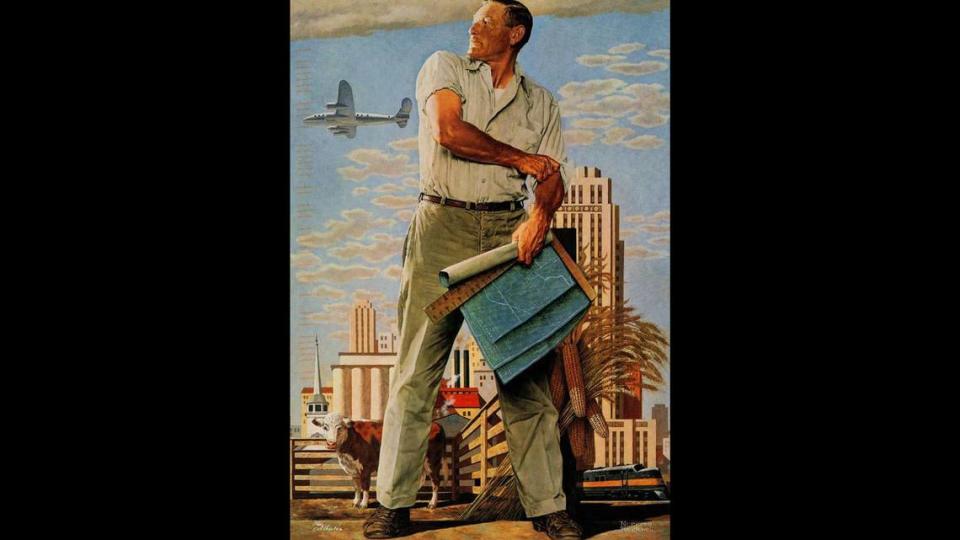
Nearly 75 years later, it’s as indelible and compelling as ever.
But it’s effectively hidden in plain sight, despite a prominent display at the vibrant, warmly welcoming (and free) but underappreciated and inconspicuous Hallmark Visitors Center — which takes some alert meandering from Crown Center to find at its 2450 Grand Blvd. address.
When I went to see the painting in person for the first time recently, there were only a few people there, up until a large Hallmark Media Los Angeles group arrived for a tour. Several friends I’ve spoken with either hadn’t realized it was there or known about it at all.
That’s a shame, really. Because it’s an abiding treasure to be seen in person — and it comes with a remarkable backstory.
Not that it’s in itself anonymous.
It remains the artwork that compels the most requests for reproductions, said Erin Dodson, curator of the Hallmark Art Collection.
“People call us asking about that all the time,” she said. “So to me that is probably that thing that speaks most to the resonance of it: that people continue to still be so interested in it (and that) perhaps it is a powerful image and an interesting story and a curiosity.”
The prolific Hallmark Art Collection is a story in itself. But it speaks to Hall’s personal relationships and partnerships with artists, among many others, such as Winston Churchill — better known for having saved the world as British prime minister during World War II — Salvador Dali, Saul Steinberg and Rockwell.
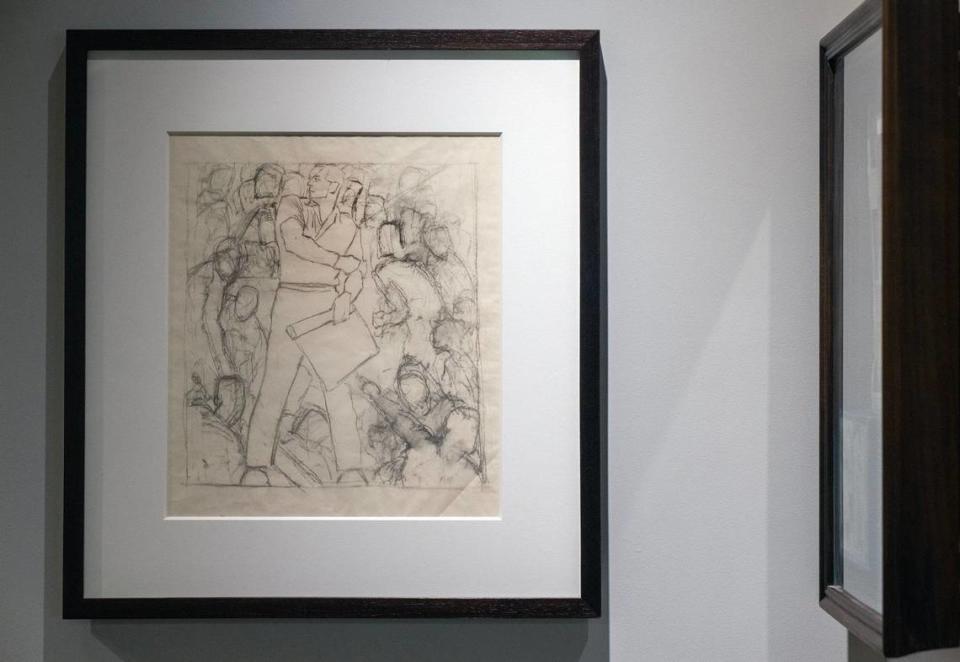
But this particular endeavor with Rockwell was a different enterprise.
It was about a region reeling. A city that needed both a morale boost and to project its resolve.
And it was about Hall’s belief in “The Kansas City Spirit” as almost a living, breathing trait … and Rockwell’s ability to conjure that.
Today, that concept might ring hollow in some ways. Being part of that spirit hasn’t always been inclusive and accessible, and we’ve got a lot of catching up to do with those who’ve been left behind.
Still, the notion remains an ideal to aspire to that’s also been certified by inflection points in our history.
No, we don’t just mean the Royals managing a stunning eight comeback wins on their way to winning the 2015 World Series, or the Chiefs becoming the only NFL team to rally from double-digit deficits in every postseason game en route to winning Super Bowl LIV.
“The Kansas City Spirit” has been an undercurrent for at least 140 years.
And while the identity of the model for Rockwell’s vision of the spirit apparently is unknown, that was secondary.
Because Rockwell literally and figuratively was drawing on a model of Hall’s deeply held conviction.
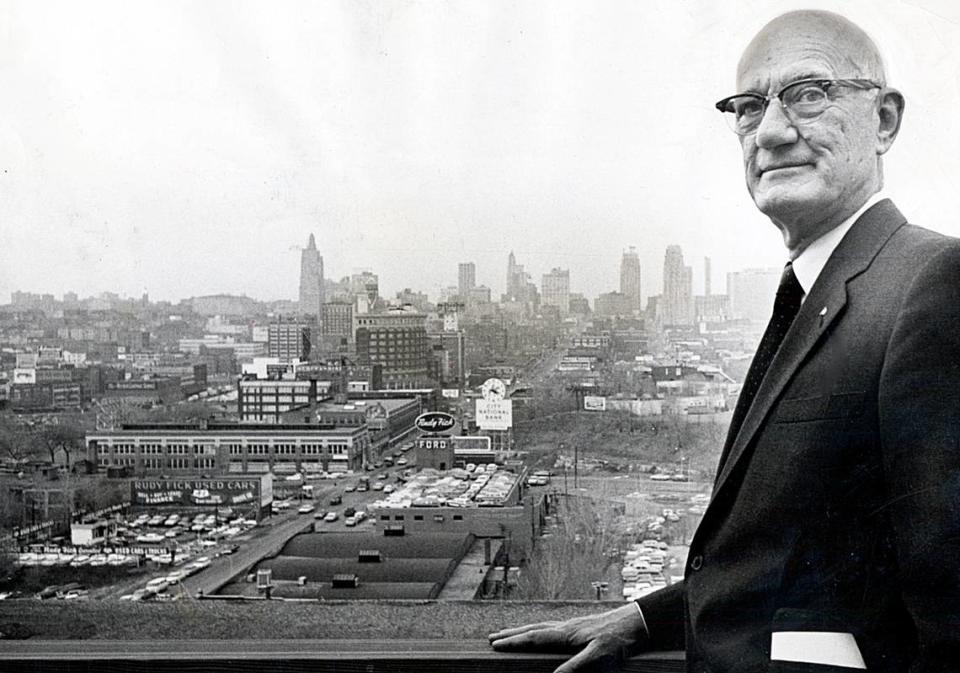
A spirit of … ‘get up and git’
The enterprising Hall was only 18 years old when he came to the conclusion that Norfolk, Nebraska, was too small to realize all he wanted from the family’s wholesaling Norfolk Post Card Co. When he was inclined to move to Omaha, a Kansas City cigar salesman named Jim Conway one day entered the store to warm himself by a fire and persuaded him otherwise.
Hall was “kind of scared going to a bigger city,” he once told the Omaha World-Herald. But there was something he found particularly enticing about Conway’s portrayal of Kansas City.
“I came to Kansas City in 1910, not because of its size or importance, but because I’d heard about the Kansas City Spirit, and I believed it to be a community where my future was worth risking,” the Hallmark founder wrote in a 1965 full-page ad in The Star beseeching “all Kansas Citians to work toward a great revival of the Kansas City Spirit.”
It’s hard to say just when that notion was born. But it goes back to at least an 1885 reference in The Star saying “the old Kansas City spirit is not dead yet” as the city pursued an exposition building.
A spirit of what an 1899 ad in The Star referred to as “get up and git.”
The most substantial version of what informed Hall’s move here took place on April 4, 1900.
Kansas City’s year-old Convention Hall burned down just three months before it was supposed to host the Democratic National Convention.
But per The Star’s Jeffrey Spivak on the 100th anniversary, even as the hall was collapsing, Kansas City businessmen Walter Dickey and Uriah Epperson were soliciting pledges from onlookers to launch the rebuilding.
“We have suffered a great calamity,” Epperson said two days later. “But Kansas City spirit, Kansas City pluck and Kansas City money will restore Convention hall.”
Never mind that Carnegie Steel Co. declared supplying the necessary steel in time would be impossible.
“In Kansas City,” the rebuilding committee replied, “we don’t know what ‘impossible’ means.”
The convention took place as scheduled.
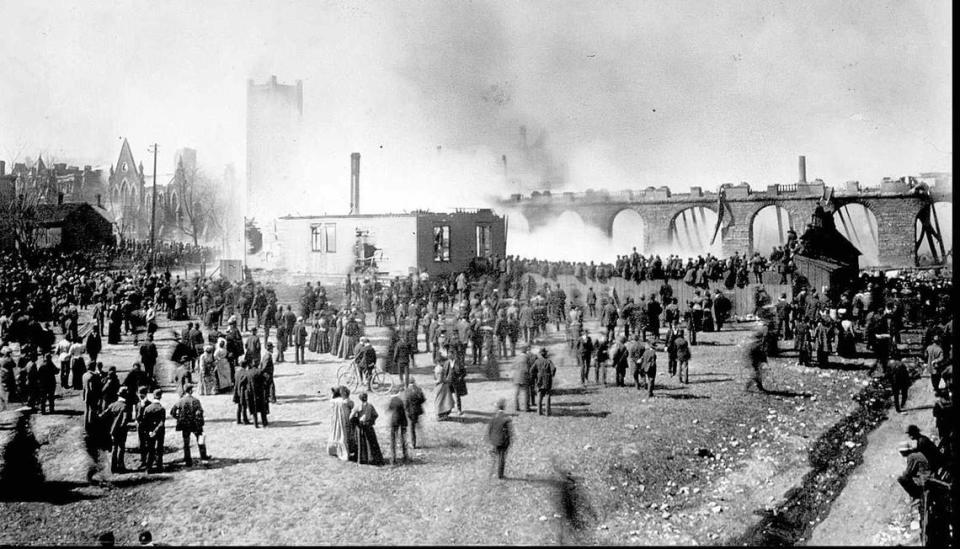
‘The flood has revived it’
All of that revealing history and civic pride is what Hall sought to summon from Rockwell when his friend called to ask how he might help after the West Bottoms had been ravaged in July 1951.
Hall’s relationship with Rockwell went back to at least 1948, when he commissioned the man who perhaps remains America’s most famous illustrator and commercial artist to create Christmas cards for Hallmark. Measured in dollars, a U.S. Senate report that fall called the flood “the greatest single catastrophe in the history of this country.”
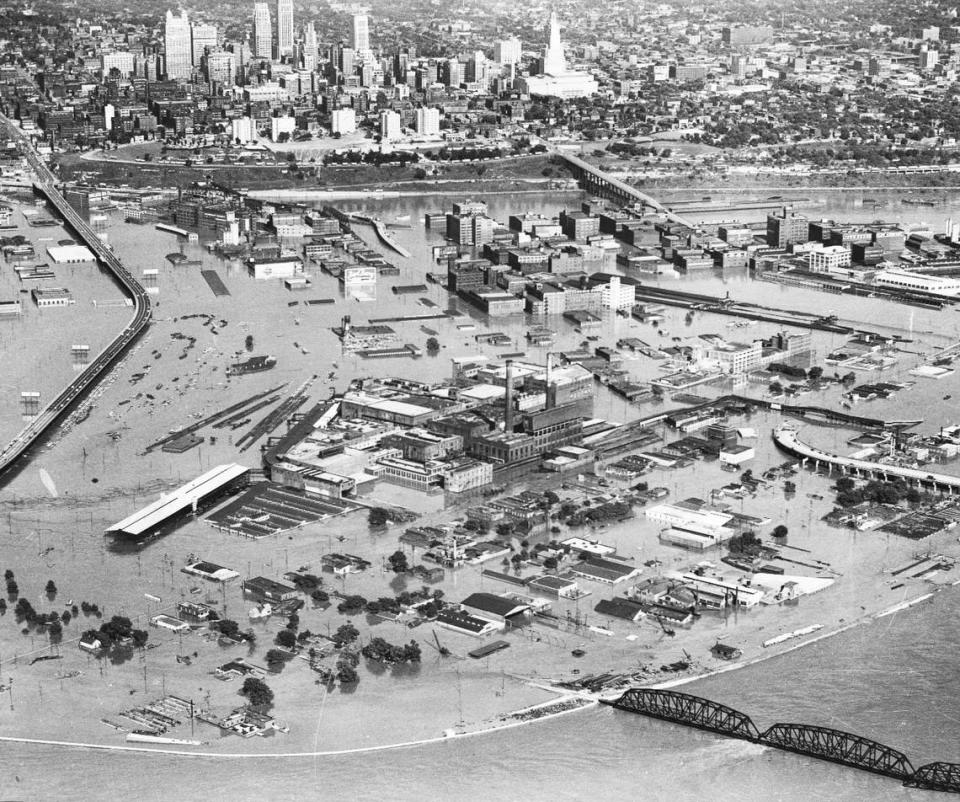
Wire service stories around the nation later wrote that Rockwell’s interest also was prompted by an editorial in The Star, headlined, “You Can’t Lick Kansas City.” And The Star was part of the greeting meeting on Aug. 7, 1951, when Rockwell arrived at Kansas City Municipal Airport to meet with Hall and then-city manager L.P. Cookingham.
“Norman, this is the most important assignment you have ever had,” Hall told him at the airport. “It will rank up there with your ‘Four Freedoms’ of World War II fame.
“This is the story of a courageous city fighting back after a terrible blow by a giant flood. This is the story of a big man, rolling up his sleeves and going to work — without whimpering and crying.”
He added, “Some will tell you the ‘Kansas City spirit’ is dead. That’s not so. The flood has revived it.”
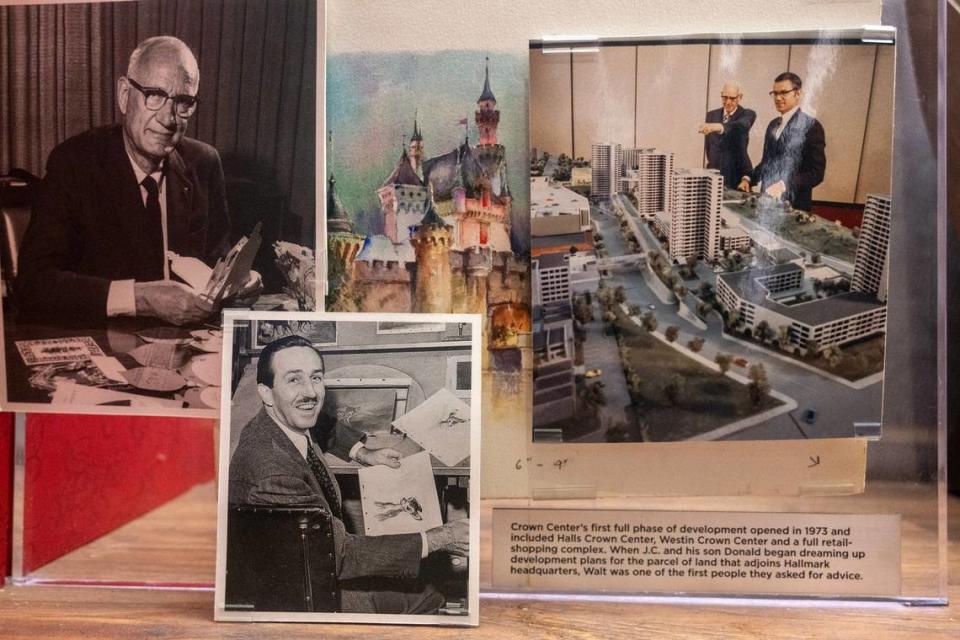
‘You really have to see the original’
Rockwell spent several days in Kansas City sketching images he took home to Vermont to process.
That led to what Hallmark records describe as a number of potential compositions, including a sketch that hangs alongside the final product in the visitors center depicting dozens of would-be animated people surrounding the central character.
That was a stark contrast to the finished product — and to Rockwell’s usual approach.
“I feel like (the adjacent sketch) is more like what a Norman Rockwell painting might normally look like … with a lot of attention to each individual expression on the faces,” Dodson said. “That probably was his gut reaction: ‘I’ll show the spirit of Kansas City by showing all of these different portraits of people.’
“But then he came around to this other image as a different solution.”
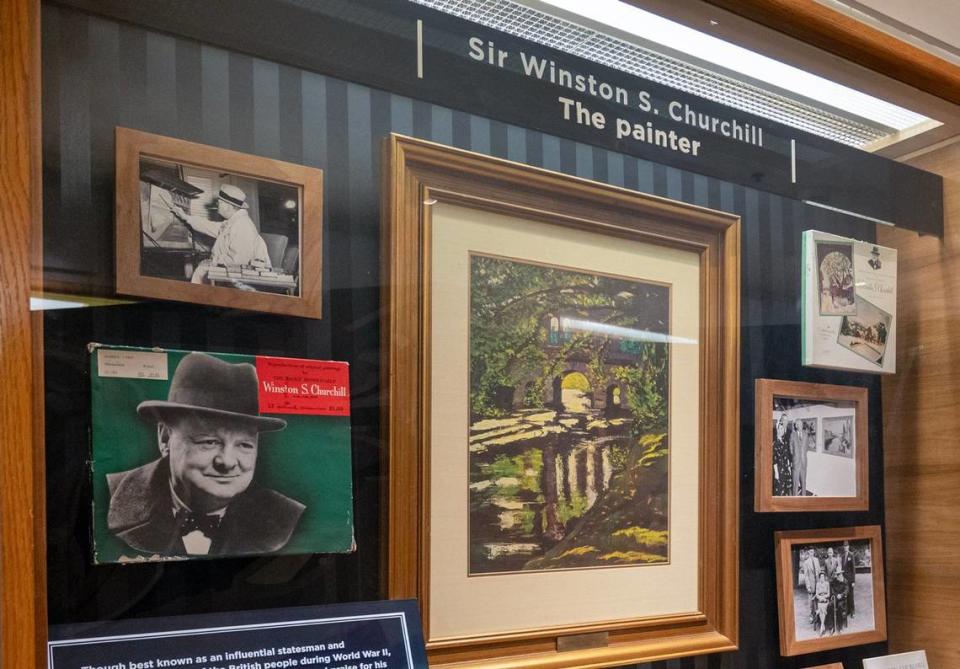
Though it’s unclear how the broader image evolved, Dodson noted it was typical of Rockwell and Hall to go back and forth about Christmas card ideas.
Whatever the case, it was delivered with a unique twist.
In what would prove to be the only known collaborative drawing of Rockwell’s professional career, the cityscape background conjuring Kansas City’s then-skyline was drawn by Rockwell’s friend John Atherton.
Beyond Rockwell’s enthralling dominant figure, it’s accented by the meshing of urban and agricultural images, including a plane and train moving opposite ways and a cow, corn and wheat seeming to signify our roots and direction.
“Painting architecture just really wasn’t part of (Rockwell’s) normal process as far as I know,” Dodson said.
Another fitting distinction for “The Kansas City Spirit” — which is all the more to be appreciated in person and led me to buy a print suitable for framing for $19.99.
While Rockwell was “an incredibly talented painter,” Dodson said, we mostly only have seen his work on cards or plates or prints.
Or, in our case, a ceramic made by my late mother-in-law.
“So it’s like you kind of think that you know what his work looks like,” Dodson said. “But then actually to see it in person, there (is) such great technical ability with paint that … at least at the time was not represented well in reproduction.”
She added, “He wasn’t just making images. He was making these fantastically painted works; you really have to see the original to get the full impact of that.”
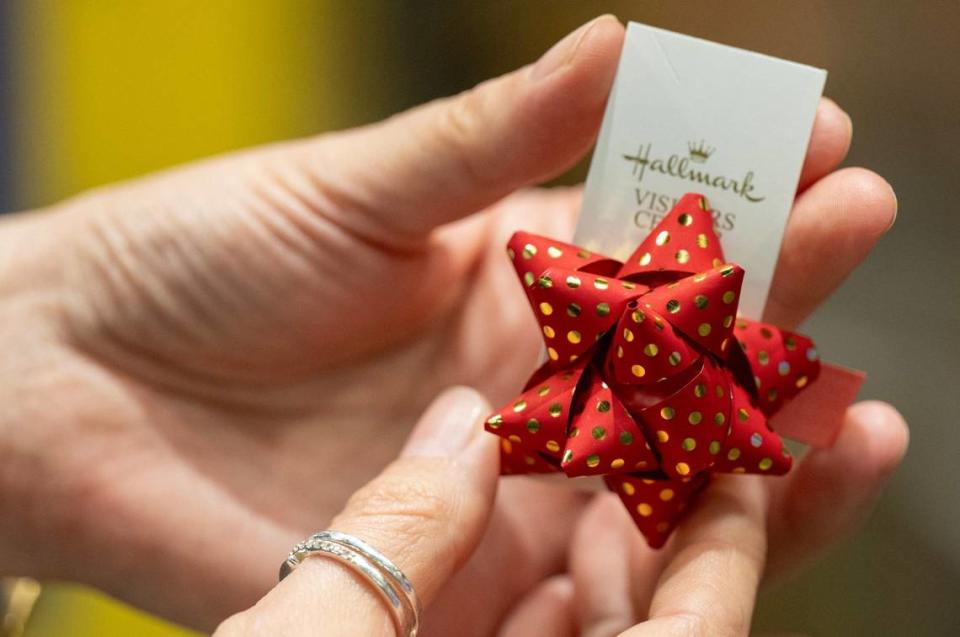
Other Hallmark Visitor Center highlights
▪ Adjacent displays feature Hallmark’s notable connections with U.S. President Dwight Eisenhower and British Prime Minister Winston Churchill. Hallmark founder Joyce Hall developed relationships with both statesmen and encouraged their artistry. Churchill’s paintings after World War II inspired by Eisenhower to embrace the hobby, largely painting landscapes and portraits — including of Abraham Lincoln and Churchill.
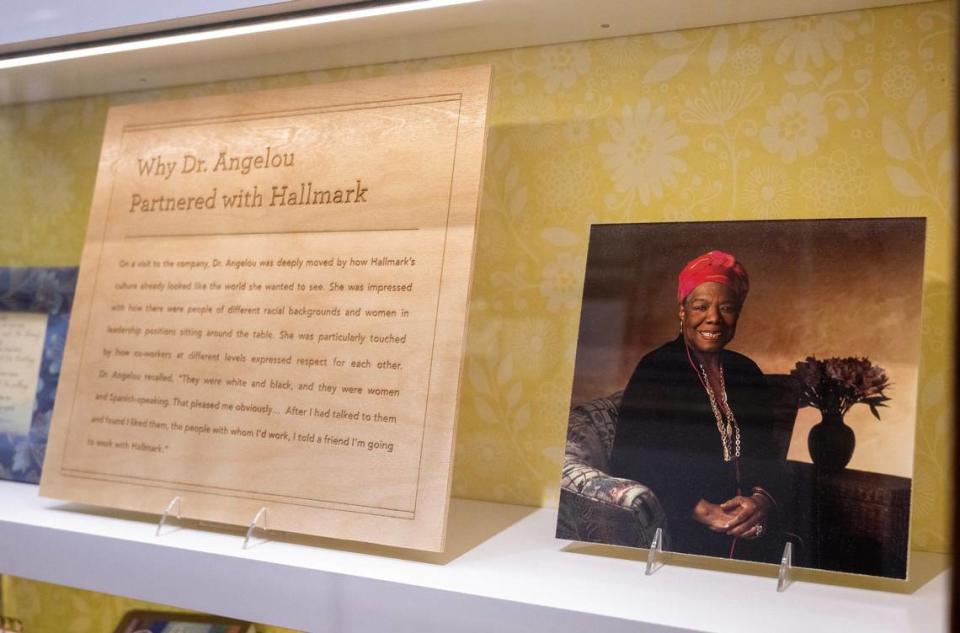
▪ Also notable is a display of poet Maya Angelou. She partnered with Hallmark in the “Life Mosaic” product line because she appreciated the company’s diversity in leadership and saw it as an “opportunity to take her message of compassion, understanding, and transformation to a larger audience,” as The National Endowment for the Humanities wrote.
▪ The timeline display and 14-minute film offer revealing looks at the rise of Hallmark, the entertaining work of its own creative artists through the years and interesting history of Kansas City itself.
▪ You can push a button and watch a bow be made instantly — and take it home as a souvenir — but take some time for the J.C. Hall Christmas Tree collection.
▪ “J.C. & Walt — A Lasting Partnership” chronicles the history of Hall’s relationship with Walt Disney, whose inspiration for Mickey Mouse is said to have been sparked during his years in Kansas City. The display is soon to be expanded, and Hallmark will be loaning additional archival materials to Union Station for an upcoming Disney100 exhibit.
The Hallmark Visitors Center, 2450 Grand Blvd. in Crown Center, is open from 9:30 a.m. to 4 p.m. Tuesday through Saturday and is closed Sunday and Monday.


